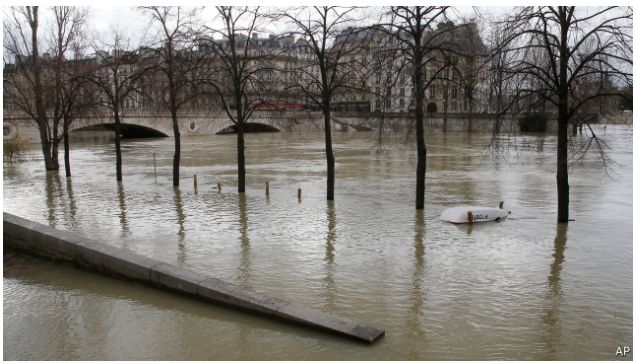https://www.economist.com/blogs/economist-explains/2018/01/economist-explains-24
Two years after it last struggled with floods, the metropole (现代都市) is reeling (沦陷) once more
IN mid-2016 the River Seine (塞纳河) in central Paris burst its banks (溃坝). It rose to 6.1 metres, briefly closed the Louvre (卢浮宫) and Musée d’Orsay (奥赛博物馆), disrupted trains and affected businesses and homes. The cause: intense rainfall in much of western Europe, which led to the worst flooding in the city for 34 years. Now the waters are back. By January 29th the river had reached the 5.8 metre-mark, causing similar disorder. Some 1,500 people have been evacuated from their homes. Rats are fleeing sewers (下水道). Locals at one vulnerable spot downstream from the city, Ile de Migneaux, told a newswire (新闻专线), L’Agence France-Presse, that they have endured eight swampings (大水) in two decades. Are such floods becoming more common, and more disruptive, in Paris?
No flood in the past century has come close to matching the one of January 1910, when the Seine rose to 8.6 metres, overwhelming sewerage systems (下水道系统) and making canals of many streets. It took until March for the waters to recede (减退). (And even that does not match 1658, when the river surpassed 8.9 metres.) By tradition Parisians (巴黎人) measure the river’s height against the statue of a soldier, Zouave, on the side of the Pont d’Alma. Waters this week washed his thighs. In 1910 they wet his shoulders. Experts suggest that in any year Paris has a 1% chance of a really calamitous (灾难的) flood because of heavy rainfall. But human intervention can be problematic, too. Sewers and railway tunnels (铁路隧道) move flood waters across the city. And as Paris has grown, so has the potential economic damage from rising waters. The OECD [经济合作与发展组织(Organization for Economic Co-operation and Development)], a rich-country think tank, reckons the floods of 2016 cost over €1bn. Were a 1910-style whopper (something unusually big) to strike again, the inundation (洪水,泛滥) would affect 5m people and could inflict damage costing anything between €3bn and €30bn.
More frequent flooding is possible. Climate change is set to bring more intense bursts of rainfall to northern and western Europe. This winter has seen the heaviest downpours (倾盆大雨) of the past half-century. But the European Environment Agency (EEA) (欧洲环境署) does not judge the French capital to be especially exposed. In 2012 it identified around 20% of large European cities (ie, with over 100,000 residents each) that were at particular risk, meaning 40% or more of their territory could be covered by rivers rising by only one metre. These were most notably in the Netherlands, Croatia (克罗地亚), Slovenia (斯洛文尼亚), Greece and Finland. Paris, by this measure, is resilient (有复原力的). The concern for the French capital is more human in origin. The city’s old sewers carry both rainwater and household effluent (家庭污水). Worse, so much soil in the city is “sealed” with asphalt (沥青;柏油), concrete (混凝土) and the like (at least 75%, says the EEA), that water runs quickly to sewers and the river. Human tinkering (修补) also affects perceptions of floods. If Zouave’s feet seem to get wet more often, that might be because he was moved to a different position by the bridge in the 1970s.
Parisian authorities are increasingly active in raising awareness of floods. They are also doing more to prepare for and mitigate them. One example is upriver (上游区域), at the La Bassée project, where flood waters are to be diverted into gravel pits (沙坑) and marshland (沼泽地). Work will begin in 2021, says the OECD. Meanwhile, high waters will continue generating far more attention in Paris than in most cities. Coastal areas are generally more vulnerable to floods, given storm surges, high tides and rising sea levels. But Paris is extraordinarily picturesque, draws millions of tourists yearly and has many riverside landmarks and museums. It is also home to research centres and institutions that analyse the impact of floods and suggest ways to tackle them. The Paris Region Planning and Development Agency, for example, produces animations that help to show how different districts would be affected by especially severe swamping. When a one-in-100 year flood does strike again, the city will at least not be taken by surprise.
